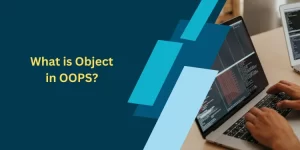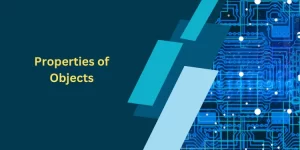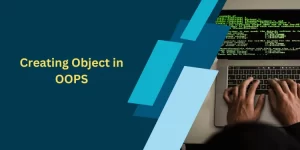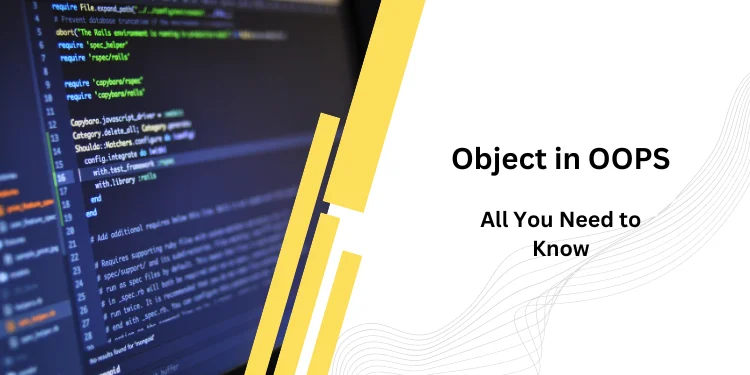Table of Contents
ToggleIntroduction
Object in OOPS Object-Oriented Programming is a widely used and highly influential programming paradigm that has completely transformed the way software is developed. It has become the preferred approach for many programmers due to its efficient and organized structure. At its core, Object in OOPS revolve around the concept of objects, which are considered to be the fundamental building blocks of this paradigm. An object can be thought of as a self-contained entity that encapsulates both data and behavior.
This means that an object not only holds information or data but also has the ability to perform certain actions or functions. In other words, it combines both attributes and methods into a single unit. This allows for a more modular and flexible approach to programming as different objects can interact with each other in a meaningful way.
What is Object in OOPS?

In Object-Oriented Programming (OOP), an object serves as a fundamental unit, embodying both data and functionality within a software system. Think of an object as a tangible instance derived from a blueprint known as a class. This class defines the properties, or attributes, characterizing the object’s state, and the methods, or behaviors, representing the actions the object can perform. Picture a class as a template and an object as the realization of that template, akin to baking multiple cakes using a single recipe. Object in OOPS encapsulate their internal workings, promoting a modular and organized code structure through principles like encapsulation, inheritance, and polymorphism.
Ultimately, in the realm of Object in OOPS, objects are the cornerstone, facilitating a more intuitive and efficient approach to designing and implementing complex software systems.
Have a look at the following: data structures in java
What is an Object?

In the world of programming, an object refers to a specific instance that is created from a class. But what exactly is a class? Think of it as a blueprint or template that outlines the common characteristics and actions shared by all objects of its kind. To put it simply, a class can be compared to a recipe, while an object is the tangible result of following that recipe. In essence, a class serves as the foundation for creating multiple objects with similar attributes and functionality. Just like how a recipe specifies the ingredients and instructions needed to create a dish, a class defines the properties and behaviors that will be inherited by its objects. It acts as a guide for developers to follow when creating new instances of that particular type.
Properties of Objects

Object in OOPS have two main characteristics: state and behavior.
State:
The state of an object can be understood as the combination of its unique and defining characteristics, also known as its attributes or properties. These properties serve to differentiate one object from another and provide insight into its overall makeup. For instance, let’s take the class “Car” as an example. The state of an object belonging to this class can be described by a set of attributes that give it distinct qualities. These may include features such as its color, model, and speed. Each of these properties contributes to the overall identity of the car and plays a crucial role in defining its purpose and functionality.
The color attribute, for instance, reveals the visual appearance of the car and can range from vibrant hues to muted tones, making it stand out or blend in with its surroundings. Similarly, the model attribute indicates the specific make and design of the car, which can vary greatly between different manufacturers and styles.
Behavior
In the world of programming, every object is defined by a set of characteristics and behaviors that make it unique. These behaviors are determined by the methods associated with its designated class. A method can be thought of as a set of instructions that an object follows, dictating its actions or operations. For instance, let’s consider the example of a “Car” class. This class would have various methods associated with it, each representing a specific action that the car can perform. These behaviors may include essential functions such as “accelerate,” “brake,” and “changeGear.” With these methods in place, an object belonging to the “Car” class would be able to carry out these actions seamlessly.
It is crucial to note that an object’s behavior is not limited to just the methods explicitly defined within its class. In fact, it can inherit behaviors from other classes through inheritance or implement new ones through interfaces. This allows for greater flexibility and functionality in creating objects with unique sets of behaviors.
Creating Object in OOPS

In the world of programming, objects are created and derived from classes. A class serves as a blueprint or template that defines the properties and behaviors of an object. When an object is instantiated, it means that a new instance of that class is being created, with its own set of values for the attributes defined in the class. In simpler terms, an object can be thought of as a specific version or manifestation of its class, with its own unique characteristics and features. By creating objects from classes, developers are able to efficiently organize and manage data in their programs, as well as create dynamic and interactive applications.
Each time an Object in OOPS is instantiated, it is given a unique identity within the program, allowing for multiple instances of the same class to exist simultaneously. This concept of instantiation plays a vital role in object-oriented programming and is crucial to understanding how classes and objects work together to create robust and flexible code.
python
# Example in Python
class Car:
def __init__(self, color, model):
self.color = color
self.model = model
def accelerate(self):
print(f”The {self.color} car is accelerating.”)
# Creating objects
car1 = Car(“Blue”, “Sedan”)
car2 = Car(“Red”, “SUV”)
# Accessing object properties
print(f”Car 1: {car1.color} {car1.model}”)
print(f”Car 2: {car2.color} {car2.model}”)
# Invoking object methods
car1.accelerate()
Encapsulation:
One of the key principles of Object in OOPS is encapsulation. It refers to the bundling of data (attributes) and methods that operate on the data within a single unit, i.e., the class. This ensures that the internal workings of an object are hidden from the outside world, promoting modularity and ease of maintenance.
Inheritance:
Object in OOPS can inherit properties and behaviors from other objects through a mechanism called inheritance. This allows for code reuse and the creation of a hierarchy of classes.
Polymorphism:
Polymorphism, another Object in OOPS concept, enables objects of different classes to be treated as objects of a common base class. This promotes flexibility and extensibility in the code.
Conclusion
To summarize, objects serve as the fundamental building blocks of Object-Oriented Programming, providing a powerful and efficient means of structuring and designing software. By encapsulating data and behavior within a single entity, objects allow for a highly organized and modular approach to development. This not only promotes better code organization, but also facilitates easier maintenance and scalability. One of the key principles underlying Object in OOPS programming is encapsulation, which refers to the act of concealing the internal workings of an object from external entities. This allows for better control over how data is accessed and modified, ensuring that it remains consistent and secure.
By adhering to this principle, developers can create more robust and reliable systems. Another crucial aspect of object-oriented programming is inheritance, which enables developers to reuse code by inheriting properties and methods from parent objects. This not only saves time and effort in development, but also promotes code consistency across different parts of a project.
Frequently Asked Questions (FAQs)
What is an object in Object-Oriented Programming (OOP)?
In OOP, an object is a concrete instance created from a class, which acts as a blueprint. Objects encapsulate both data (attributes) and behavior (methods), providing a modular and organized way to structure software.
How is an object different from a class in OOP?
While a class is a template or blueprint defining properties and behaviors, an object is a specific instance created from that class. Think of a class as a blueprint and an object as the actual instantiation or realization of that blueprint.
How are objects created in OOP?
Objects are instantiated from classes. When you create an object, you are essentially creating a unique occurrence of that class with its own set of attribute values.
Can objects interact with each other in OOP?
Yes, objects can interact through their methods and by exchanging data. This interaction promotes the modularity and flexibility of OOP systems.
What role do objects play in encapsulation?
Objects contribute to encapsulation by bundling data and methods within a single unit (class). This ensures that the internal workings of an object are hidden from external entities, enhancing code maintainability.
How do objects support code reusability in OOP?
Objects support code reusability through inheritance. This allows a new class to inherit properties and behaviors from an existing class, promoting the reuse of code and the creation of a class hierarchy.
Can you provide a simple example of creating and using objects in OOP?
Consider a class “Person” with attributes like name and age. You can create objects like person1 = Person(“John”, 25) and person2 = Person(“Alice”, 30) to represent specific individuals with distinct characteristics.













